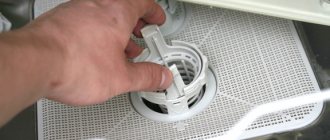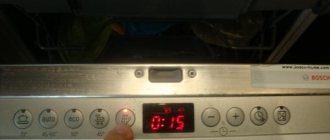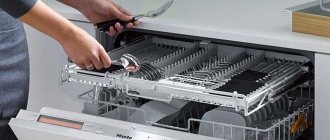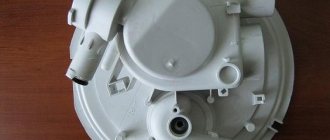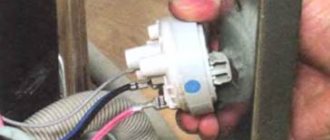When choosing a dishwasher, you should pay attention to the power rating. It can vary from 0.4 kW to 2.7 kW. Modern equipment is produced with a minimum energy consumption, on average it is 0.7 kW. The power of a dishwasher depends on the size of the water tank, the amount of liquid heated, the type of drying and many other factors.
Power and energy consumption: what's the difference?
Most people confuse these two indicators. In fact, there is a big difference between them. Energy consumption is the amount of energy that the dishwasher uses in one hour of operation . At the same time, individual parts of the PMM do not work continuously during this time.
For example, a tubular electric heater (hereinafter also referred to as a heating element) turns off after heating the water to the desired temperature. This will take him, for example, 10 to 15 minutes. The drain pump runs for a maximum of half an hour. At different stages of the operating cycle, different PMM nodes are involved, therefore the average energy consumption per hour of operation is determined. The calculation is carried out in kilowatt-hours (kW/h).
The energy consumption level is divided into classes - from A to G
Power is the amount of energy that the dishwasher takes from the electrical network in the event of simultaneous operation of all its components . How much electricity does a dishwasher use compared to its power? It turns out that the difference between the PMM power indicator and the energy consumption is very significant. Power is 2-3 times higher than the level of energy consumption, and its unit of measurement - kilowatt (kW) - is not tied to time .
The cross-section of the electrical cable supplying electricity to the device depends precisely on the power that the dishwasher has.
Types of devices
Dishwashers are usually divided into types according to the installation method.
Exist:
- Built-in. The machine is installed in a kitchen unit, and a facade is hung on its door. The main advantage of such units is the preservation of a uniform style throughout the kitchen.
- Partially built-in. The appliance is installed in a place prepared for it in the kitchen unit, but is not covered with a façade. At the same time, the control panel is located on the door, which is very convenient.
- Free standing cars. Such devices can be installed anywhere in your kitchen. At the same time, the dishwasher will have to be selected to match the design of the entire room.
Thus, based on your needs, you can choose the most suitable type of dishwasher for you.
Electricity consumption classification
PMMs are classified not by power, but by energy consumption. All large household appliances have labels that indicate the level of energy efficiency of models of various brands - Bosch, Siemens, Electrolux and many others. The information on the tags of almost all products is systematized in the same way (see figure).
The sticker contains comprehensive information about the technical characteristics and operating efficiency of dishwashers
Interesting fact: such an indicator as power is not on the tags. There are energy efficiency classes. The most energy-efficient products are assigned classes A+++, A++, A+, and A.
Depending on the class, electricity consumption increases as follows:
- A+++ – 0.63 kW/h and less;
- A++ – from 0.65 to 0.75 kW/h;
- A+ – from 0.75 to 0.85 kW/h;
- A – from 0.85 to 1.05 kW/h;
- B – around 1.05–1.2 kW/h;
- C – in the range of 1.2–1.5 kW/h;
- D, E – from 1.5 to 2.3 kW/h.
Information about classes F and G is no longer relevant today. Most buyers choose products with classes from A to A+++.
What components and parts affect energy consumption?
Each dishwasher consists of a certain set of components and parts. They all consume a certain amount of energy. The level of its consumption depends on the following components:
- The heating element is the most energy-consuming element. The power of this device that heats water for washing dishes varies widely and can exceed 2 kW. Its operating time depends on the water temperature level that is set in the selected program. The temperature range is quite wide - from +30...35 ℃ to +70...80 ℃. PMM models with forced drying have another heater that increases the air temperature, as well as a fan. Unlike devices with convection drying, such dishwashers have a higher energy consumption level.
- Circulation pump - pumps liquid into the nozzles of the spray arms, and also ensures the reuse of water in order to save it. The power of this pump is low, approximately 100 W. The longer the dishwashing program lasts, the more energy the appliance consumes.
- Drain pump - pushes waste fluid into the sewer. Pump power – from 30 to 40 W. The duration of its operation depends on the amount of dirty water that needs to be removed from the PMM.
Dishwasher drain and circulation pumps (bottom view)
Energy consumption indicators depend on several other factors:
- The amount of liquid consumed per washing cycle. The indicator ranges from 7-15 liters. The more water, the longer it needs to be heated. The operating time of the drain pump also depends on the volume of water.
- Duration of the washing process. The time depends on the program selected by the user and varies widely - from 40 minutes to 4 hours. This indicator affects the total energy consumption of the circulation pump.
- Basket sizes. This indicator determines the number of tableware that can be washed in one cycle, and affects all others. If we compare narrow and full-size PMMs, the latter will require more water to operate, as well as a more powerful electric heater and pump for sprinklers. The units of small tabletop dishwashers have the lowest energy consumption and power.
The countertop dishwasher is the least productive, but the most economical of all types of PMM
Typical malfunctions of Electrolux dishwashers
Like any technical device, dishwashers tend to break down sometimes, which is caused by stress during operation, as well as improper conditions of use and maintenance. In order to facilitate troubleshooting, the manufacturer has stored error codes corresponding to a particular breakdown in the device’s memory.
Error codes for Electrolux dishwashers
| Error code | Symptom of a malfunction | Malfunction |
| i10 | The indicator blinks once at 5 second intervals. | There is no water filling into the machine. |
| i20 | The indicator blinks twice. | There is no water drain. |
| i30 | The indicator flashes three times. | The leakage protection has activated. |
| i50 | The indicator flashes five times. | The circulation pump is faulty. |
| i60 | The indicator flashes six times. | Other reasons, including:
|
The table shows the most common types of breakdowns and their corresponding codes. Other faults and codes can be found in specialized workshops that repair household appliances.
Dishwasher repairs should only be carried out by qualified personnel.
Electrolux dishwasher repair
Repair of Electrolux dishwashers can be classified into three degrees of complexity:
- simple - which can be done independently, without the involvement of specialists, the error code is i10, and the reasons: the tap is closed or the water supply hose is squashed, and the filter installed in front of the inlet hose is clogged;
- medium complexity - can be performed on site, but this requires certain knowledge or calling a specialist. This category includes the following types of malfunctions: replacing the pump that drains water (error code - i20), cleaning filters and hoses, as well as repairing control buttons;
- complex - performed in specialized workshops by qualified personnel.
Spare parts for Electrolux dishwashers
In our country there are specialized centers that repair Electrolux brand household appliances, so if there is such a workshop nearby, then it is best to go there. In this case, the installation of original spare parts will be guaranteed and a warranty period will be provided for the work performed.
Specialized centers are the best choice when household appliances break down. In addition, original components and spare parts can be ordered through online resources; fortunately, it has its own dealers in our country, and its representative offices are in many regions.
Useful tips for using dishwashers
If you properly allocate resources and operating time of the dishwasher, you can save energy. Follow the recommendations below:
- Wash dishes at night when electricity rates are lower. To do this, you need to have a two-tariff electric meter and a PMM, which has a delayed start function. In the evening, turn on the device, select a washing program, start it and wait until the water in the tank finishes filling. Then stop the program and enable delayed start. Firstly, in the time before restarting, the water will have time to warm up to room temperature and less energy will be needed to heat it up. Secondly, the work cycle will be performed at night, when the electricity tariff is lower.
- Don't keep dishes dirty for too long , as dried food waste makes them more difficult to clean. You will have to run a program with soaking, double rinsing and washing at a higher temperature. Naturally, such a choice will lead to more energy consumed.
- Choose your washing program wisely - do not wash slightly soiled dishes with hot water for too long. For effective cleaning, an accelerated mode at a liquid temperature of +30...40 ℃ may be sufficient.
- Try to load the dishwasher as much as possible . Running a partially loaded PMM is impractical due to inefficient use of electricity. But if your model has a half-load function, use it.
- Regularly descale the heating element of your dishwasher. If the heater is covered with a layer of scale, it heats the water much worse, while consuming the same power as before.
Today, stores offer a wide selection of dishwashers for any family. When choosing, be sure to pay attention to energy efficiency rating labels - this will save you from unnecessary costs when paying bills in the future. You will find tips on choosing dishwashing equipment in our other article.
How to make it more economical
There are several ways to reduce the amount of electricity consumed. The most common are the following:
- Selecting a program with delayed start. Some dishwasher models have a half load mode. Its use can reduce water and energy costs by 30%.
- Use of equipment with a heat exchanger. This technology reduces costs by 20%.
- Carrying out periodic maintenance of household equipment involves cleaning the heating element from scale. A thick layer of mineral deposits can significantly reduce heating efficiency. The use of special filters to reduce water hardness also solves the problem of scale formation. Prolonged use with scale on the heating element can lead to wear and failure. At the same time, repairs will be expensive and difficult to carry out on your own.
- It is recommended to leave the dishwasher overnight. This ensures filling.
- For washing lightly soiled dishes, it is recommended to choose economical modes. They use a small amount of water and heat to lower temperatures.
In addition, it is not recommended to leave dirty dishes for a long period, since dried food remains require more energy to clean.
